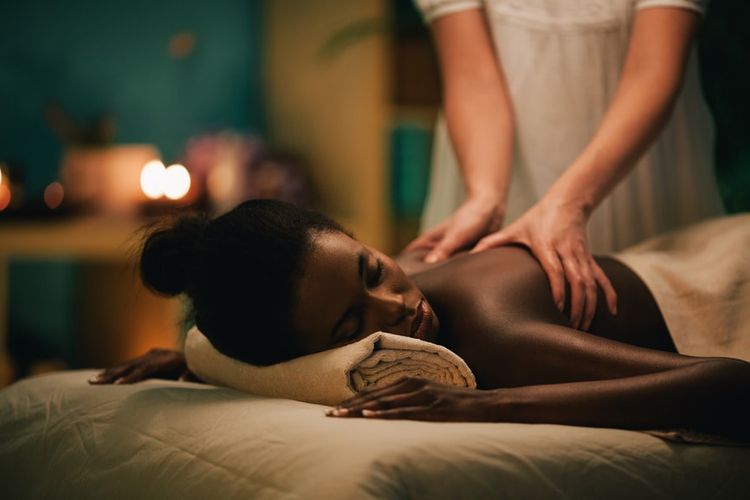Does the idea and of treating yourself to a massage simply bring on the feeling of relaxation? Did you know that massage therapy does far more for your body than just provide a way of relaxation?
In this article, we will go over what massage therapy is, how it works, its benefits, side effects, and much more - get ready to find out more about massage therapy and if it is the right choice for your wellness needs.
What is Massage Therapy?
Massage therapy is a form of healing massage, as practiced by a licensed massage therapist or other qualified health professional. There are many different traditions or modalities of massage. Massage therapists may practice one or more types of massage when working with their clients or patients.
3 Health Care Providers Who May Use Massage Therapy
Massage can be an effective way of working with structurally related conditions like back pain and can also help reduce the need for treating such pain with medication. Outside of massage therapists, massage is commonly used by the following types of healthcare providers:
1. Sports medicine doctors
2. Physical therapists
3. Athletic trainers
These three types of healthcare providers often use massage to help speed recovery and improve performance for athletes.
5 Places to Receive Massage Therapy
Massage therapists can work either as solo practitioners or as part of a larger medical team. Many massage therapists make home visits. There are many other locations to go for massage therapy. Here is a list of five places to go to receive massage therapy:
1. Spa
2. Office
3. Clinic
4. Chiropractor
5. Hospital
How Does Massage Therapy Work?
Massage therapy uses a variety of methods to manipulate the body in order to promote healing. The client typically lies face down on a massage table, although some massages can be performed in a chair. Clients either wear loose clothing or are naked but covered by a sheet. The therapist uses their hands, fingers, elbows, knees, or feet to apply pressure to your muscles, joints, ligaments, and tendons. This typically results in feelings of release and decreased pain, although some soreness can also occur.
Massage therapist Margaret Kampney says, "The main impact of massage is that it softens the connective tissue everywhere, helping re-establish flow in the lymph system. When toxins and cell debris leak out of capillaries, the lymph tubes are meant to pick that up. Somebody has to take out the trash! Massage restores that healthy process."
4 Basic Characteristics of all Massage Therapy Types
Massage has been practiced in various forms for thousands of years and exists in cultures around the world. However, all forms of massage share basic characteristics. Here is a list of characteristics that all types and forms of massage therapy have in common:
- The massage therapist applies gentle pressure, most commonly with their hands, to the soft tissues of your body.
- Massage therapy releases tension and promotes relaxation and wellness.
- Massage therapy causes muscle and connective tissue to release and lengthen.
- Massage therapy typically results in feelings of relaxation and decreased pain.
Types of Massage
There are dozens of different types of massage. Most have similar benefits, however, some techniques may be more appropriate for working with specific health conditions. Massage therapists may be trained in one approach or several.
Swedish massage, the most common massage technique practiced today, was developed in the 19th century. Swedish massage became increasingly popular in the United States over the 20th century, after being first introduced in the 1850s. Other schools of massage have also become common, including Thai massage, traditional Chinese medicine techniques such as acupressure, and deep tissue massage. Related approaches such as Rolfing have also been developed in recent decades.
6 Types of Massage
Here is information on six types of massage:
1. Swedish Massage
Swedish massage is what most people probably envision when they think of massage. Swedish massage is full-body and includes a series of techniques in which the therapist uses their palms, fingers, and forearms to apply pressure and motion. The amount of pressure is typically light to medium, although some parts of massage may involve greater pressure. Swedish massage is often used in spas to promote relaxation, but can also be effective for treating back pain.
2. Pregnancy or Prenatal Massage
Some massage therapists are specifically certified to work with pregnant women. They can provide valuable prenatal care, helping a pregnancy to go more smoothly. Massage during pregnancy can help relieve back pain, aches, and strain on the mother's body, and decrease emotional stress. One study has even shown that the benefits of massage are present during pregnancy and during labor and delivery.
3. Deep Tissue Massage
Another common form of massage, deep tissue massage is a method that works with certain muscles and connective tissue that other massage techniques may not reach. Deep tissue massage uses slow movements and more pressure than most other massage approaches in order to reach deeper layers of muscle and release tension. Deep tissue is often used for pain relief.
4. Thai Massage
Traditionally practiced in Thailand, but now popular worldwide, Thai massage reflects a variety of influences including; traditional Chinese medicine, Ayurvedic teachings, and ancient Thai approaches to healing. Thai massage practitioners use their feet, as well as their hands, to apply pressure and implement massage techniques. Thai massage also includes stretching and moving the client's body into yoga positions.
5. Sports Massage
Sports medicine doctors and other health professionals frequently use massage when working with athletes. Massage can help athletes to perform better, lower the risk of injury, and recover more quickly after a workout. Sports massage may include a range of techniques and types of massage.
6. Lymphatic Massage
The lymphatic system helps eliminate toxins and tissue waste in the body, carrying them in a fluid called lymph. Lymphatic drainage is a type of massage that helps to support the lymphatic system. Typically, lymphatic massage uses light pressure and circular motions on the skin to stimulate the flow of lymph.
Next, acupressure. Wait, is acupressure a type of massage?
Is Acupressure a Type of Massage?
Do some people find themselves wondering, is acupressure a type of massage? It is. Acupressure is also similar to acupuncture. Acupressure is a technique that evolved as part of traditional Chinese medicine. Acupressure involves applying pressure to acupuncture points on the body, instead of the fine needles used in acupuncture. The pressure helps to promote the free flow of life energy, or qi, through the body. Acupressure is used by traditional Chinese medicine doctors as a part of their practice and has been found to be effective for treating back pain. Would you like an in-depth understanding of acupuncture? Read more:What is Acupuncture?
How Does Massage Help?
Most people are familiar with the fact that massage helps to break up the tension and relax the muscles. But how else does massage affect the body? Here is a list of how massage helps the human body:
? First, massage can impact the nervous systems, which includes the brain, spine, and nerve endings located throughout the body.
? Second, massage stimulates nerve endings in the skin. This helps to bring aspects of the nervous systems into balance, including the sympathetic and parasympathetic nervous systems.
? Third, the sympathetic and parasympathetic nervous systems control the body's stress response and can put the body under a great deal of strain unless they are functioning properly.
? Fourth, massage helps improve that functionality. This is why a massage feels so relaxing?it can help deactivate the stress-inducing and often overstimulated sympathetic nervous system and activate the regenerative and relaxing parasympathetic nervous system.
3 Other Body Systems Massage Helps
There are three other body systems that massage helps with:
1. Circulatory system: The circulatory system distributes oxygen and essential nutrients throughout the body.
2. Lymphatic system: The lymphatic system is the body?s way of removing waste and toxins, which are carried out of the body?s tissues in a fluid called lymph, and eventually excreted.
3. Digestive system: Massage has been found to promote the free flow of blood and lymph through the body. Massage can also affect the digestive system, and stimulate the muscles of the digestive organs, helping to eliminate waste.
7 Ways Massage Therapy Works
Outside of relaxation, massage therapy works for many different ailments in healing. Here is a list of seven different things that massage therapy works for:
1. Reduce pain
2. Healing from injury
3. Improve circulation
4. Reduce tension in the musculoskeletal structure of the body
5. Alleviate anxiety and depression
6. Reduce stress
7. Contribute to feelings of well-being
Benefits of Massage Therapy
Massage can lower your stress, help you relax, reduce pain and otherwise boost your wellness. One important caveat: you generally need to receive regular massage sessions in order to sustain the benefits.
?Massage goes way beyond feel good,? says Margaret Kampney. ?When older people have their feet massaged, they can feel their feet better and walk more securely. When your shoulders are massaged, you'll notice how incredibly tense they are, and mindfully relax them. Massage has the effect of reprogramming the brain - a huge benefit to health. The big theme is always mobilization, allowing the body to heal itself by re-establishing flow. Motion is life.
7 Benefits of Massage Therapy
Massage therapy is well known as one of the many beneficial holistic therapies for back pain. For an in-depth understanding of how massage benefits back pain and acts as holistic therapy for back pain, read our guide: Massage for Back Pain
Now let's get more detail on seven benefits of massage therapy:
1. Pain Relief
Massage is a classic way of treating back and neck pain. Contemporary research continues to back up this approach. A massage can help relieve pain, both by breaking up muscle tension and scar tissue around the back and neck and by increasing blood flow in the area. This can have the added benefit of reducing or eliminating the need for pain medication. There is some evidence that massage can also help with fibromyalgia.
2. Improved Circulation
A massage can often improve your circulation. Massage stimulates the tissues, releasing blockages and increasing both blood and lymph flow. This helps to get more oxygen to our muscles and organs while carrying away waste.
3. Support During Pregnancy and Childbirth
Massage may be a useful method of relieving pain during pregnancy and childbirth. Some research has found that massage both directly reduced the amount of pain women experience, as well as made other pain relief approaches more effective. Massage during childbirth can also convey emotional support through physical touch and help the birthing process go smoothly.
4. Speeding Recovery After Workout or Injury
Trainers and sports medicine professionals often use massage as a treatment for athletes who want to speed recovery after a workout. Post-exercise massage can reduce inflammation in muscle tissue and diminish soreness. Regular massage can also help some injuries heal more rapidly.
5. Relaxation and Stress Reduction
You don't have to be in pain or unwell to benefit from a massage. Many people enjoy massage simply as a method of relaxation. Stressed or worn out? A massage can leave you feeling refreshed, invigorated, and enlivened.
6. Boosting Mood, Reducing Depression and Anxiety
Massage is an overall mood booster - most people report feeling higher levels of well-being after a massage. However, for those who experience depression and anxiety, the effects can be especially profound, because their normal mood may be especially low. A massage can help alleviate symptoms of depression and anxiety, giving some relief and ease.
7. Supporting Cancer Treatment
A growing body of research indicates that massage is a useful complementary therapy for people undergoing cancer treatment. Chemotherapy and radiation typically leave people feeling exhausted, in pain, and sick. Massage therapy can help reduce pain levels and help you to feel greater well-being. However, is important to work with a massage therapist who specifically understands how to perform massage on cancer patients, as certain areas of the body - including tumor sites, damaged or sensitive skin, and veins with blood clots - must be avoided.
Safety and Side Effects of Massage Therapy
Massage therapy is a safe healing technique if performed by a licensed health professional. There are typically no significant side effects to massage. One study did find three side effects that should be known about massage therapy:
1. Swelling
2. Bruising
3. Allergic reaction (from lubricants used)
It is important to note that even though a massage can result in some soreness, it normally dissipates within 24 hours.
However, massage, especially more intense forms like deep tissue massage, might not be appropriate for people with certain health conditions. For example, a massage could dislodge a blood clot, or damage bones weakened by cancer treatment. The National Center for Complementary and Integrative Health found that there are a few circumstances where massage therapy may not be the best holistic therapy option.
If you have any health problems, experts recommend consulting your doctor and discussing them with your massage therapist before beginning treatment.
5 Times You Should Avoid Massage Therapy
There are five times you should avoid massage therapy. Here is a list of five conditions where it is recommended by the NIH to first seek the advice of a doctor before getting massage therapy:
1. Pregnant
Massage therapy as noted is often recommended and beneficial during pregnancy as well as labor. However, every pregnancy is different. Talking to your OB-GYN or midwife before getting a massage is always a good idea.
2. Bleeding disorders
If you live with a bleeding disorder like hemophilia, deep tissue massage should be avoided.
3. Blood thinners
Just like blood disorders, if you take blood thinners, massage therapy - especially deep tissue massage should be avoided.
4. Wounds
If you have a wound, massage therapy should be avoided particularly in the wounded area of your body.
5. Cancer
If there are areas in the body that are known to have a tumor or cancer, massage therapy should be avoided in that area.
The following expert reviewed and contributed to this article:
Margaret Kampny, LMT, RYT, PhD
References:
Corbin, L. (2005). Safety and Efficacy of Massage Therapy for Patients with Cancer. Cancer Control,12(3), 158-164. doi:10.1177/107327480501200303
Field, T. (2010). Pregnancy and labor massage. Expert Review of Obstetrics & Gynecology,5(2), 177-181. doi:10.1586/eog.10.12
Massage Therapy for Health Purposes. (2017, March 23). Retrieved December 30, 2018, from https://nccih.nih.gov/health/massage/massageintroduction.htm
Vickers, A. (2001). Massage therapies. Western Journal of Medicine,175(3), 202-204. doi:10.1136/ewjm.175.3.202













